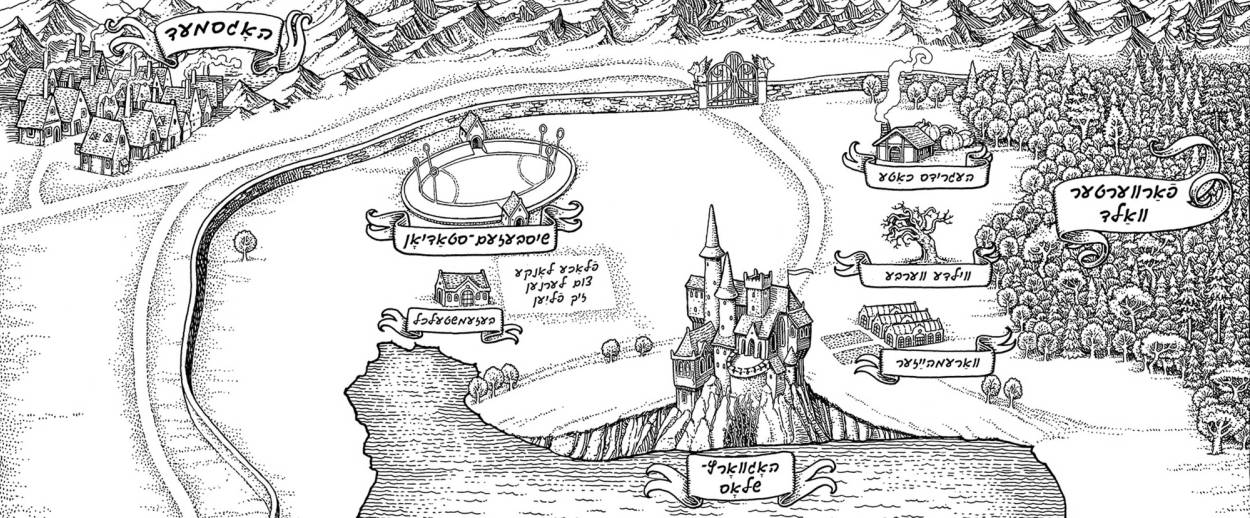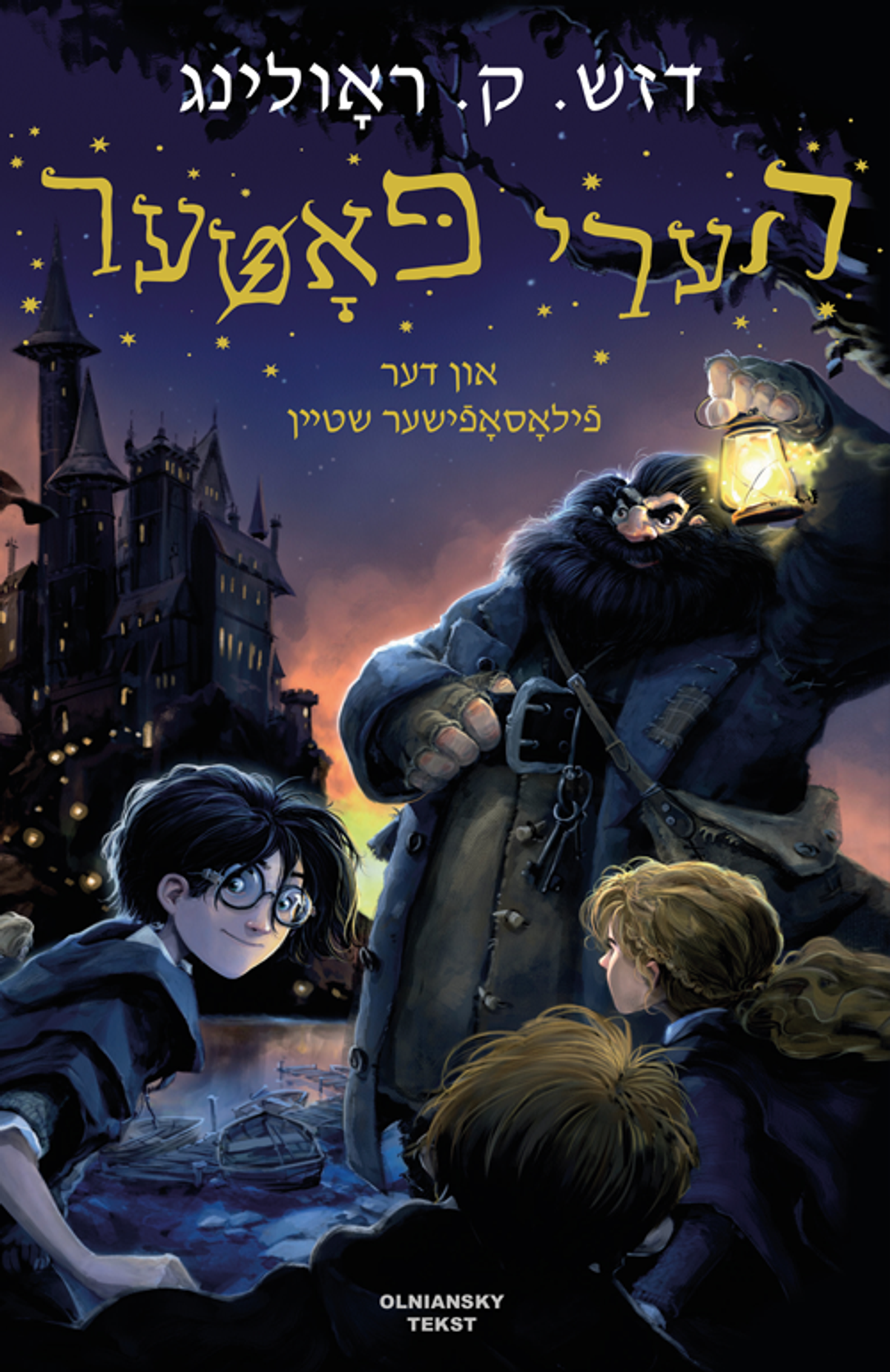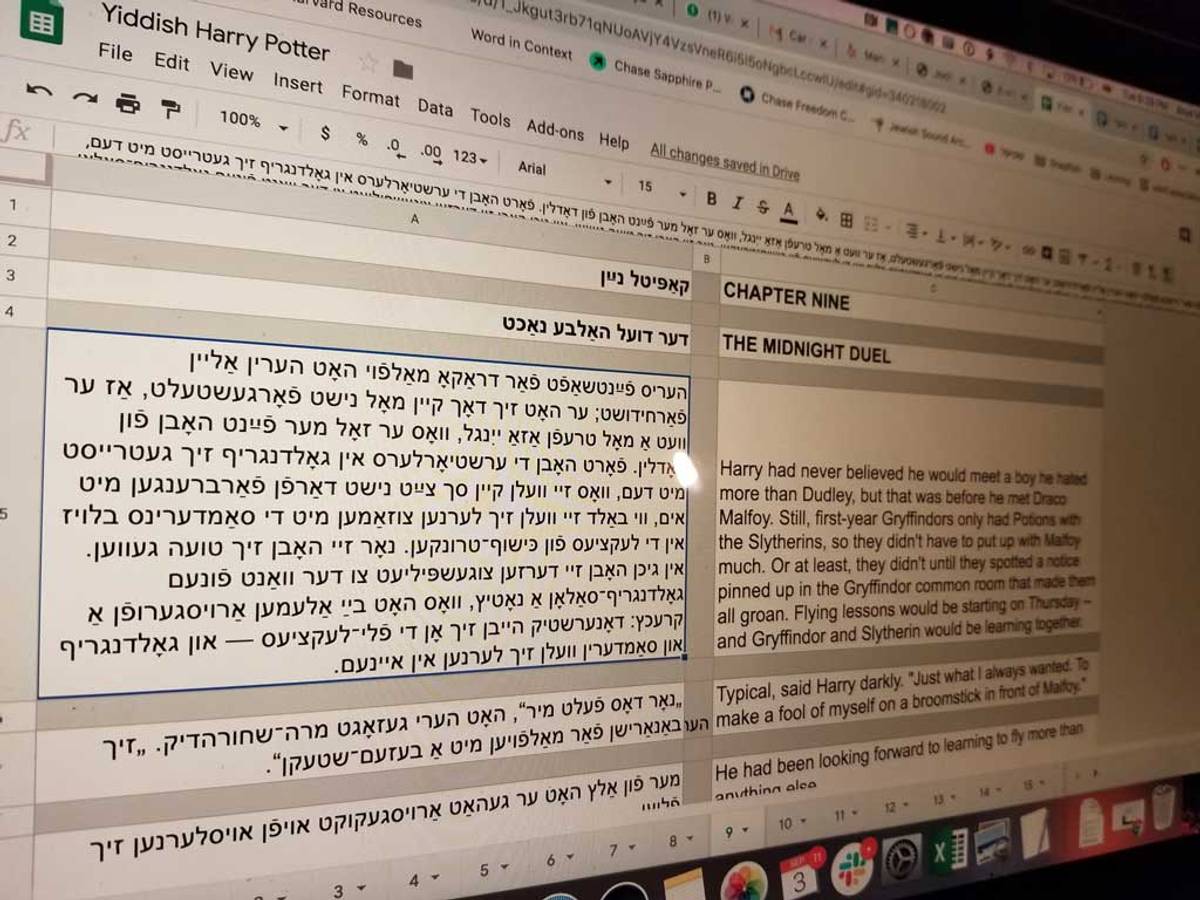How Do You Say ‘Quidditch’ in Yiddish?
The inside story of how ‘Harry Potter’ was translated into Yiddish




J.K. Rowling’s Harry Potter series is one of the most translated works of fiction in human history. Over the last two decades, it has appeared in over 80 languages, ranging from well-trodden tongues like French and German to more exotic idioms like Gaelic and Latin. Today, that collection expands to include one more, with the debut of the official Yiddish translation of Harry Potter and the Philosopher’s Stone (released in the United States as Harry Potter and the Sorcerer’s Stone).
How did such an unusual edition come to be produced nearly 23 years after its source material’s publication? The work of an Indian-American Orthodox Jewish translator, and printed by a publishing house in Sweden, the story behind Harry Potter un der filosofisher shteyn is almost as remarkable as the story it tells.
To chronicle that unlikely path to publication, I spoke with those involved at every step of the journey, from the translator himself to Rowling’s editors and agency. In the process, I learned not only how to say “Quidditch” in Yiddish, but about the hopes that have been invested in this improbable edition of the popular children’s tale.
***
The story behind the story begins in October 2018. “I’m going about my business quietly, dealing with everything else, and all of a sudden I get this pitch for a Yiddish translation almost 20 years into Harry Potter being published,” recalled Rowling’s agent, Neil Blair of The Blair Partnership. The inquiry from the prospective translator read, in part:
Having grown up with Yiddish as a mother tongue, I always wished that I could experience the magical world of witchcraft and wizardry in my beloved language. Modern, engaging children’s literature was practically non-existent; instead, my siblings and I, along with our Yiddish-speaking peers, had to make do with outdated works, often dating back before World War II. In fact, the idea for this project came out of a Saturday afternoon conversation with my wife as we were sitting in our living room rereading various books from the series; she turned to me and said, “… how are we going to raise our kids in a language that doesn’t have Harry Potter?” I am also painfully aware of the lack of accessible pedagogical material for adult students, being a Yiddish teacher myself. As with the translations into Latin and Ancient Greek, a translation of Harry Potter into Yiddish would provide students with a modern, familiar, and exciting mode to practice and engage with the language, and generate additional enthusiasm for the study of Yiddish.
Intrigued, Blair passed the inquiry on to his colleagues, only to discover that they’d already given the Yiddish rights to a publisher—in Sweden. Surprised at the level of interest in this ostensibly obscure translation, Blair connected the publishing house with the prospective translator.
The publisher was Nikolaj Olniansky, who would soon print a popular Yiddish translation of J.R.R. Tolkien’s The Hobbit, and whose work was subsidized by the Swedish government’s funding for official minority languages. The translator was Arun Viswanath, a scion of one of America’s greatest Yiddish dynasties.

Born in New York City and raised in Teaneck, New Jersey, Viswanath attended Orthodox Jewish day schools. After a gap year in Israel, he attended Harvard University, where he was the student president of Hillel, majored in linguistics, and attained conversational fluency in 15 languages. (The two of us first met in college.) Language, and particularly Yiddish, ran deep in his family. His grandfather, Mordkhe Schaechter, was a professor of Yiddish at Columbia University, and together with his siblings and children, devoted his life to the propagation and perpetuation of the language. Viswanath’s mother, Gitl Schaechter-Viswanath, is the author of the 856-page Comprehensive English-Yiddish Dictionary. His aunt, Rukhl Schaechter, is the editor of the Yiddish Forverts, the sole remaining non-Hasidic Yiddish newspaper. Arun’s mother even met his father, P.V. Viswanath, thanks to Yiddish. The elder Viswanath, an Indian economist from Bombay, came to the United States for graduate school, discovered Judaism, and found his way to a Yiddishist retreat in the Catskills. As legend has it, he dove into the lake without sufficient swimming skill, and was rescued by the lifeguard on duty, Gitl, whom he later married.
Growing up speaking Yiddish in such a storied Yiddishist family was a source of pride for the 29-year-old Arun and his siblings, but also a source of anxiety. “I was raised in this family where it was like, ‘Yiddish is your legacy and you will pass it on,’” he told me, “but I didn’t grow up in the same environment as my parents did. I didn’t have that rich thing, so there was this real angst. When I was 12, I tried to read a Yiddish short story, and I couldn’t understand it. And I was like, ‘this is really bad!’ So I kind of went crazy and started doing flashcards and trying to read as much as I could.”
This tension has proved productive for Viswanath and his sisters, all of whom are involved today in various Yiddish projects—which is how Arun came to the idea of translating Harry Potter. What better way to pass on the legacy of Yiddish to another generation, he thought, than to translate one of the most popular works of children’s literature of all time? Seized with this inspiration, Viswanath began spending evenings away from his job at a tech startup translating the first book of the series, not knowing if he’d ever be permitted to publish it.
As it turned out, though, he wasn’t the only one.
When Rowling’s agent Blair connected Viswanath with Olniansky, the Swedish publisher found himself with what he described as “a pleasant problem”: He’d already been contacted by another Yiddish translator who had also begun translating the first Harry Potter novel. Given the significance of the project, Olniansky did not feel qualified to personally decide between the manuscripts, and so he submitted samples of both translations to two expert reviewers—Jean Hessel, the Swedish government’s official for Yiddish at the Swedish Institute for Language and Folklore, and Mikhoel Felsenbaum, the noted Yiddish postmodern novelist living in Israel.
“Both of them picked Arun’s translation,” Olniansky told me, “so that’s the way we went.”
***
There are no Yiddish words in the original English edition of Harry Potter, although Rowling herself did absorb a number of Yiddishisms from Arthur Levine, her publisher and editor at Scholastic for the entire series. There is even an apocryphal story about how Levine once ribbed Rowling that one of the books was getting so long that he was going to drop in a Yiddish word just to see if she’d notice it. “I don’t remember that,” Levine laughed, when I inquired as to whether this actually happened. “That doesn’t mean it’s not true. She and I had lots of jokes like that. A totally credible story, I just can’t honestly tell you that I remember doing that.”
It was left entirely to Viswanath, then, to render Rowling’s magical lexicon into Yiddish. In doing so, he confronted some challenges faced by past translators, and others that were unique to this particular language.
One common question: What to do about names? Throughout the novels, Rowling either gives her characters traditional British monikers like Cornelius or Hermione—which have no equivalent in many foreign languages—or she chooses names that connote something about the character in question. Thus, the wizard Sirius Black is later revealed to possess the ability to transform into a black dog, as foreshadowed by his name’s reference to Sirius, the Dog Star.
As he examined prior foreign editions, Viswanath discovered that different translators had taken dramatically different approaches. “French went totally out there,” he said. “They renamed [Severus] Snape to ‘Rogue.’ In Italian they renamed him ‘Piton’ [snake]. French even changed the name of Hogwarts” to Poudlard, which means “bacon lice.” In his own work, Viswanath didn’t find such radical revisions necessary for the most part, because “Yiddish is a Germanic language, so the English sounds are not that foreign.” Thus, Harry’s classmate Neville Longbottom remained Longbottom, rather than “longtuchus.”

In some cases, however, it was necessary to rename characters to preserve Rowling’s intent, which is how Quidditch captain Oliver Wood became Oliver Holtz. In the novel, Harry is introduced to Wood by professor Minerva McGonagall after he demonstrates remarkable skill chasing another student in midair on a broomstick. Thinking he is about to be disciplined for breaking the rules, he misinterprets her meaning when she asks another teacher if she can “borrow Wood for a moment,” wondering “was wood a cane she was going to use on him?” Needless to say, this wordplay would not work unless Wood’s name referred to wood—or holtz—in Yiddish, and so Viswanath rebranded the character, even though he’d found that many “other languages don’t try to do it,” leaving readers somewhat confused.
Perhaps the most notable naming conundrum for translators actually appears in the second book of the series, Harry Potter and the Chamber of Secrets, which Viswanath has just begun to translate. In a climactic scene, the ghostly apparition of a former Hogwarts student named Tom Riddle reveals that he is actually the young Lord Voldemort, the main villain of the books. By way of demonstration, he rearranges the letters of his name “Tom Marvolo Riddle” to spell out “I am Lord Voldemort.”
As one might imagine, this English anagram is something of a problem for foreign translators operating in other languages. Some East Asian editions just throw up their hands and render the name in English, explaining its meaning to readers in a footnote. A few translations actually do the anagram in Latin. Viswanath, meanwhile, is following the Hebrew approach, taken by many foreign language editions, and simply renaming “Tom Marvolo Riddle” to give him the necessary letters to do a proper anagram in Yiddish for Voldemort. (In Hebrew, “Tom Vandrolo Riddle” becomes “Ani Lord Voldemort.”)
But Rowling didn’t just coin names, she coined many magical terms and concepts, and each of these required its own Yiddish rendering. Translating Quidditch, the fictional aerial sport played on broomsticks in which participants fire a ball through hoops to score points, posed its own challenge. “I could’ve just called it Quidditch [in Yiddish transliteration], but meh, we could do better than that,” Viswanath said. He cast about for something more authentically Yiddish. Inspiration struck when he “remembered that there’s this saying, ‘az got vil, sheest a bezem,’ which means, ‘if God wants, a broom shoots,’ and which possibly refers to somebody who’s impotent, or maybe to a gun.” And so, “shees-bezem”—or “shoot-broom”—was born. Along similar lines, rather than merely transliterate the name of the small flying “golden snitch,” whose capture ends a Quidditch match, Viswanath dubbed it the “goldene flaterl,” or “golden butterfly,” as butterflies are a common motif in Jewish and Yiddish folklore. By riffing off Yiddish sayings and symbols in this way, Viswanath hopes “people will feel the Yiddishe taam [taste].”
While Viswanath consulted other translations for guidance, they could only take him so far, as Yiddish presents some dilemmas that none of them had faced. “One real challenge for me was the cultural transposition,” he said. “How do you take this story which is very much in this Christian European fantasy tradition, transpose it into Yiddish language, make it feel Yiddish, have the characters speak in a way which feels natural to Yiddish, but not make it Jewish?”
He did not want to covertly convert the characters to Judaism, or follow the Hebrew translation, which had replaced some aspects of Christian culture with Jewish analogues, as when it swapped the song “We wish you a merry Christmas” for the Hanukkah tune “Mi yemalel.” Instead, in the interest of authenticity, Viswanath straightforwardly rendered all of the novel’s Christian elements. “I actually had to Google what a Christmas cracker was, because I didn’t know,” he said, “and then I had to translate it into Yiddish.”
At the same time, Viswanath didn’t let the book’s Christian components prevent him from infusing the story with genuine Yiddish flavor. Often, this is reflected in how the characters express themselves. They may not be Jewish, but they talk like their Yiddish equivalents would. “I recast some of the characters as certain Jewish archetypes purely on linguistic grounds,” he explained. “I turned Dumbledore into this very lomdish [Jewishly learned] guy who speaks with a lot of loshen koydesh [Hebrew and rabbinic phrases].” In other words, Dumbledore speaks in the Yiddish register of a rabbinic dean of a yeshiva because that’s the role he plays at Hogwarts, not because he’s actually Jewish.
Likewise, “McGonagall and Snape, and especially [Argus] Filch, speak in a particularly Litvish [Lithuanian] register, so you can sort of really hear their dialect. The same thing with [Rubeus] Hagrid, who speaks with a very deep back country Polish register,” a Yiddish analogue to “his west country English accent” in the original books.
The most sensitive instance of this linguistic adaptation concerns the book’s goblins, who run the wizard bank Gringotts. In the past, some have suggested that these creatures are meant to evoke an anti-Semitic stereotype, though this claim has been dismissed by Jewish advocacy organizations (Rowling herself has spoken out at some length against anti-Semitism). Viswanath, having read the books many times, agreed. Though “the general goblin trope has been associated with anti-Semitic tropes in Christian lore, I’ve come to the conclusion that it’s totally not anti-Semitic here,” he said. “There is no indication that they have long noses or that they love money. They guard the money. They don’t love money.” Instead, Viswanath imparted to the goblins a different aspect of the Jewish experience: The coded in-language of an oppressed minority in a hostile culture.
In Yiddish, the goblins refer to humans using the same terms that Jews in the Middle Ages often used among themselves to refer to non-Jews. “There was this tradition in the Middle Ages of Jews speaking Hebrew so the non-Jews wouldn’t understand what they were saying,” said Viswanath. “They couldn’t speak in Yiddish because it was too close to German, so there is this tradition of Jews in the presence of a non-Jew who didn’t understand Hebrew saying, ‘der adon is meyvin kol dibbur,’ meaning ‘watch out, this guy understands Yiddish.’” Thus, where medieval Jews might refer to non-Jews with the Hebrew word adon, the goblins refer to humans as adon. “I wanted to reflect that insularity in a very subtle way.”
***
The book took one year to translate, and another year and a half to edit. It was something of a family affair, with Viswanath’s mother and brother-in-law serving on his editorial board along with a Yiddishist friend. “He’s a perfectionist in the best sense of the word,” said Olniansky, the Swedish publisher. “He reviews everything so that it will be as perfect as possible. I think he has had three people involved editing his text, even though it would probably have been fine without them.”
Olniansky is optimistic about this edition and its first run of 1,000 copies. “I hope that publishing this crown of popular youth literature will be something that brings in people who have been maybe thinking about learning Yiddish, or maybe have learned it but haven’t found a way into the culture,” he said. “I hope we will also reach a new group of people who haven’t given Yiddish a thought before.”
Viswanath, for his part, explains his aspiration for the translation with a story. “As part of the process of trying to get the copyright,” he recalled, “I called up the Hawaiian translator [Keao NeSmith], who is this remarkable guy. He learned Hawaiian from his grandmother when he was 18. Very few people still speak Hawaiian at this point. Most people on the mainland don’t; there’s this island where there’s still a self-sufficient Hawaiian community. But he learned Hawaiian from his grandmother to fluency and he translated Harry Potter, and it really raised the status of Hawaiian as a minority language, and it gave the broader Hawaiian community a lot of pride.”
“Now,” he went on, “Yiddish has produced a world class literature that parallels most major languages, so it’s silly to say ‘I want to raise the status of Yiddish.’ But my hope is that people should know that Yiddish is this vibrant thing and it’s relevant today.”
Yair Rosenberg is a senior writer at Tablet. Subscribe to his newsletter, listen to his music, and follow him on Twitter and Facebook.